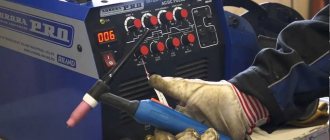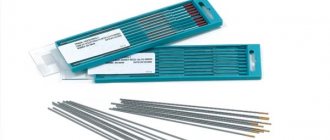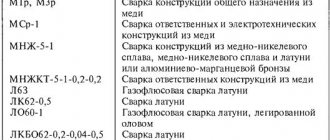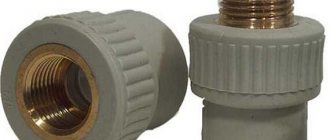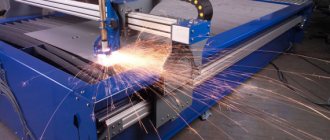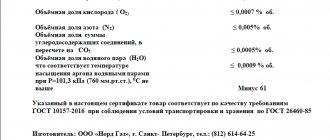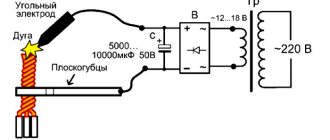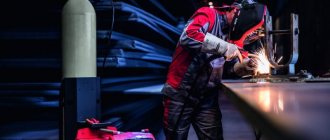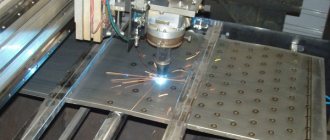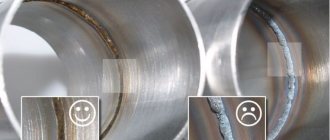11.22.2019 Author: VT-METALL
Issues discussed in the material:
- What are the features and advantages of argon welding of stainless steel?
- How to prepare materials for argon welding
- How is argon welding carried out using a non-consumable tungsten electrode?
- What is argon welding of stainless steel semi-automatically?
- What is important to consider when argon welding stainless steel
Stainless steel is a rather difficult material for welding. However, the use of welding with argon cooling allows you to obtain an even and high-quality seam connecting stainless steel parts. It is necessary to begin learning this process by becoming familiar with the various characteristics of this difficult alloy to join. Our article will introduce you not only to what argon welding of stainless steel is, but also to the features and technology of the work.
Basics of argon welding of stainless steel
Stainless steels differ from ordinary steels in their anti-corrosion properties, which they obtained by adding chromium (up to 20%), nickel, manganese, molybdenum and other components. These impurities give the metal different properties and performance qualities. As a result, this leads to difficulties in argon welding of stainless steel.
The main properties of stainless steels are:
- Thermal conductivity is two times less than that of low-carbon steels. The outflow of heat from the argon welding site occurs very slowly, as a result of which the working area can overheat and burnout is possible. Therefore, the welding current should be 20% less than when working with other steels.
- The coefficient of linear expansion of stainless steel is high.
Accordingly, the change in the length of the product during heating will be significant, which can lead to its deformation or the appearance of cracks. To prevent this, it is necessary to make sufficiently large gaps between the parts being connected, especially large ones. - High specific electrical resistance - as a result of which the electrode rod heats up. To obtain a high-quality connection, you must follow the rule - to create short seams, use long electrodes with a higher resistance. When argon welding large areas, it is necessary to take electrodes measuring 35 cm.
An important feature of stainless steel is the loss of anti-corrosion properties at the joint when heated to temperatures above +500 °C. The reason is the formation of carbides at the grain boundaries, which take on the role of anodes. They lead to an increase in the rate of intergranular corrosion of alloys.
We recommend articles on metalworking
- Steel grades: classification and interpretation
- Aluminum grades and areas of their application
- Defects in metal products: causes and search methods
To protect stainless steel from overheating during welding, the argon cooling method is used. And for chromium-nickel alloys - technology for rapid cooling of the weld.
Features of argon welding technology
Welding is carried out in an argon atmosphere, which creates protection against oxidation at the junction of two metal parts. Oxidation occurs due to exposure to oxygen in the air. Argon creates a protective shell around the treatment area and does not allow oxygen to penetrate into this area.
Argon welding can be performed in manual, semi-automatic and automatic modes. A broader classification of welding modes is generally accepted, depending both on the method and on the electrodes used. Thus, two types of electrodes are used: consumable and non-consumable. In the second case, the electrode is a tungsten wire, which provides a reliable and durable connection of any metals, including those with different properties.
Tig welding methods are classified as follows:
- manual using a non-consumable electrode RAD;
- automatic using a non-consumable electrode AAD;
- automatic using a consumable electrode AADP.
Main advantages of the technology:
- relatively low heating temperature, which allows you to maintain the configuration of the elements being connected;
- maximum protection of the treatment area from oxygen due to the high density and inertness of argon;
- high thermal power of the arc, allowing the work to be completed in a fairly short time;
- simplicity of the process, thanks to which beginners can use the technology;
- universality of technology application, which allows welding metals and their alloys of different properties, which cannot be joined by other methods.
Argon welding technology (video):
.
Among the disadvantages of the technology:
- Sensitivity of argon protection to wind and drafts.
When the wind blows, the gas partially evaporates, leaving the connection unprotected and, accordingly, reducing its quality. For this reason, welding work using an argon jet should be performed in ventilated, draft-free enclosed spaces.
- Structurally complex welding equipment, difficulties in setting its operating modes.
- The need for additional cooling of connections when using a high-ampere arc.
Argon welding is widely used to connect copper, titanium, aluminum, bronze, steel products, as well as elements made of stainless steel and non-ferrous metals. Welding work with these metals presents a certain complexity, and it is argon technology that shows its greatest efficiency here. Using this technology, various metal parts, pipes and finishing elements are connected. The technology of welding stainless steel pipes with argon has become widespread in modern industry.
Technology for welding stainless steel pipes with argon (video):
Advantages of argon welding of stainless steel
When choosing an option for welding work on stainless steel, argon welding has a number of advantages that are determined by the technology, namely:
- To obtain an even weld with uniform penetration to the entire depth, it is necessary to protect the metal from exposure to air during operation. Argon helps to do this, creating a special atmosphere around the work site, displacing N2 and O2.
- This method helps to connect parts of complex shapes without changing their configuration due to the low thermal conductivity of stainless steel. Only a small area near the seam is heated. On the one hand, this is good, but on the other, you need to act very carefully so that burnout does not occur.
- The connection occurs quite quickly because the arc temperature is high.
In addition to its advantages, argon welding also has disadvantages. To carry it out, you need complex and expensive equipment, as well as certain work experience, knowledge of the material and the process.
Advantages of welding pipes with argon
Inert gas does not react with heated metals and alloys. There is no slag left on the resulting neat and precise seam, and smoke does not form in the air as when working with coated electrodes. When welding pipes with argon, the filler rod is supplied in the required quantity, which prevents the occurrence of sparks and splashes.
Local heating of the pipe section eliminates the deformation of elements in steel structures of complex shape. Being heavier than air, argon displaces oxygen from the working bath. This ensures the cleanliness of the seam, prevents the ignition of aluminum, and creates opportunities for welding corrosion-resistant steels, as well as bronze, aluminum, magnesium, copper, tin, etc.
Due to their susceptibility to oxidation, pipes made of non-ferrous metals are not welded using electrodes without the supply of argon or helium. When alloys interact with oxygen, an oxide film is formed on the surface, which interferes with the creation of a strong weld. Inert gases create a neutral environment and prevent refractory oxides from entering the pipe joint area.
How to set up argon welding on stainless steel: preparation nuances
An important stage that influences the final result is the process of preparing stainless steel for subsequent argon welding:
- Carefully process the edges of the parts with a wire brush, sandpaper, or perform automatic grinding.
- Degrease with acetone, alcohol or gasoline.
- Position the parts to be welded with clearance for expansion.
- Heat the edges of the parts to +200…+300 °C when working on thin stainless steel. This will help reduce the tension in the metal and avoid cracks.
The next stage is the selection of filler material or wire. There should be more alloying additives in it than in stainless steel intended for welding. The cross-section of the wire is selected based on the thickness of the parts being connected.
Welding large diameter pipes with argon
When connecting products with d more than 110 mm, a flux paste made from a silicone binder and a dry charge is used to protect the root joint. It is practiced to supply argon inside the pipe. Instead of filler wire, a meltable metal insert is used - a backing ring. It is grabbed from the outside in several places with a fillet seam. Welding of pipeline joints with d 219 mm and more is carried out simultaneously by 2 craftsmen, and more than 800 mm - by 2 pairs of specialists working alternately.
Tying of stainless and steel pipelines
Argon welding technology with a non-consumable tungsten electrode
Using a tungsten electrode, argon welding is used to connect parts with thin walls (thin-walled). This method is called TIG welding.
Two types of devices are used for work: direct or alternating current. Argon is supplied through a torch with an inserted tungsten electrode. The seam is formed by melting the filler wire, which is fed manually. The burner is also moved manually, holding it strictly at an angle of 70–80° to the seam.
The burner moves along the connection line, without transverse movements. In this way, a stable weld pool is formed, excluding the ingress of atmospheric oxygen and its interaction with the metal. It is recommended to simultaneously supply argon from both the front and back sides of the seam. Despite the higher gas consumption, the quality of the connection will be higher.
The electrode should not come into contact with the surface of the stainless steel. To ignite the arc, carbon or graphite plates are used, and then it is transferred to metal. This is done to prevent melting of the electrode and the absence of marks on the welding seam.
Modes of automatic and semi-automatic welding of aluminum in argon with a consumable electrode
When welding with a consumable electrode and especially thin electrode wire on semi-automatic machines, the correct choice of parameters is necessary, taking into account the characteristics of aluminum alloys. Their thermal conductivity is of great importance; as it increases, the penetration depth decreases with increasing welded thickness.
The operating voltage of the arc plays an important role. Its value depends on three components: the composition of the shielding gas (argon grade), the strength of the welding current and the feed speed of the electrode wire. Approximate welding modes are shown in the table:
Modes of automatic and semi-automatic welding of aluminum welding with a consumable electrode in argon
| Metal thickness, mm | Electrode wire diameter, mm | Type of connection and preparation for welding | Current strength, A | Operating voltage, V | Wire feed speed, m/h | Welding speed, m/h | Argon consumption, l/min | Number of passes |
| 4 | 1,0-1,5 | Butt welding, without cutting, double-sided welding | 120-250 | 19-55 | 325-360 | 25-29 | 10-12 | 2 |
| 10 | 1,6-2,0 | 250-300 | 25-30 | 290-325 | 15-25 | 14-18 | 2 | |
| 5-6 | 2,0 | Butt, without groove, lined | 260-300 | 23-25 | 250-290 | 15-25 | 11-12 | 1 |
| 15-16 | 2,5-3,0 | Without cutting, one-sided welding | 380-430 | 24-28 | 145-215 | 11-15 | 12-16 | — |
| 20-22 | 3,0 | 420-480 | 30-33 | 215-250 | 11-15 | 14-18 | 2-4 | |
| 25-30* | 4,0 | Double-sided, with X-shaped groove | 480-540 | 28030 | 145-215 | 11-15 | 15-20 | 4-6 |
| 5 | 2,5 | 400-420 | 26-32 | — | 11-15 | 16-22 | 5-8 | |
| *When welding metal 40-50mm thick, subsequent passes are performed at the following mode: current 420-450A, voltage 26-28V, welding speed 23-25m/h | ||||||||
When welding horizontal seams, the current should be reduced by 10%, and when welding vertical seams - by 17%.
Semi-automatic argon welding of stainless steel
Semi-automatic argon welding greatly simplifies the process, increases its speed, and also improves the quality of the weld. Most often, semi-automatic machines are used to connect parts of large thickness.
There are several features of argon welding of stainless steel using a semi-automatic machine:
- use of nickel-containing wire;
- consumption of carbon dioxide together with argon when joining thick parts - the edges of the seam are wetted with gas, reducing heating, which leads to a softening of the entire process;
- the use of three connection methods: with a short arc, with jet transfer technology or a pulse method.
It is believed that the greatest control of the process occurs during pulse welding, when the wire is fed into the work area in jerks. At the same time, its consumption is reduced, which is important due to its high cost. The heating area of the metal is reduced. Spattering is reduced.
This results in reduced post-finishing time for surfaces close to the weld because there is no molten metal splash.
How does the work happen?
To weld, you need special equipment, such as a torch.
The torch, designed for welding in an argon environment, is equipped with a tungsten non-consumable electrode - the main part on which the device operates.
The electrode is located outside the device body (approximately 2-5 mm).
Video:
On the inside, the burner is equipped with a special holder, thanks to which you can use electrodes of different sizes - the holder is able to fix them all.
However, the size of the electrode is selected in accordance with the metal that will be processed, and the energy consumption during operation also depends on it.
Next to the electrode inside there is a nozzle made of ceramic - it is put on so that it surrounds the electrode. With the help of a nozzle, gas will flow into the work area, so this element is also very important.
To work with your own hands, you will definitely need an additive, or, in other words, filler wire - it is made from a material the same as metal blanks.
The diameter of the filler wire must also correspond to the metal you are processing - its exact size can be found in a specialized table.
Welding in an argon environment in manual mode is the most accessible method, easily repeatable with your own hands for beginners.
In this case, the filler wire and torch must be held by the welder.
Before you start welding, you need to degrease the surface of pipes, discs made of steel, brass and other metals with which you are working, and also clean them from oxidation.
Cleaning can be done mechanically or chemically, depending on your preferences and capabilities.
The first stage of welding is the same as in the arc process: a “mass” must be applied to the workpiece.
If you are processing small parts made of steel or other material, then the feed can be carried out simply into the area of the workbench or bath where the work takes place.
With this welding method, there is no wire in the electrical circuit and will be fed separately a little later.
The torch should be fixed in one hand of the master, and the wire in the other. The burner is always equipped with a button that regulates the supply of gas and current.
Gas should be supplied earlier - 20s before the start. When choosing amperage and pressure, you need to focus on the type of material being processed, or your past experience of working with your own hands.
IMPORTANT TO KNOW: Technique for welding thin metal with an inverter
The torch, equipped with an electrode, should be located very close to the material you are working with - at a distance of about 2 mm.
At this distance between the metal and the electrode, an electric arc will appear that can melt the edge of the parts; you just need to direct it in the right direction.
The entire welding process can be followed in a video for beginners - watch it before you start working with your own hands.
This proximity of the location between the electrode and the metal is explained by the fact that in this case a short arc is obtained, and it determines how deeply a part made of steel, stainless steel or other material will be fused.
If the arc is large, then the seam will turn out to be very wide and ugly, this will be especially noticeable on the coating of pipes, disks or decorative objects made of stainless steel, brass, etc.
In addition to the aesthetic factor, a large seam makes the welding of lower quality - the larger it is, the less stable it is, and the greater the stress in it.
The filler wire is fed into the work area through slow, gradual movements: the torch should move along the seam, avoiding crossing the seam across.
The quality of the seam depends on how well the equipment works, as well as on the skills of the craftsman: the smoother and clearer the movements, the better you can make a seam on the surface of pipes, disks made of stainless steel, brass or other metals.
If the wire is fed through the equipment too sharply, the metal will begin to splash, which can be dangerous.
Reproducing the argon welding technology correctly with your own hands is not so easy if you have never done it - smooth and accurate movements are achieved only through practice.
However, it is not worth starting to learn argon welding, because... this is a very complex process.
When working, it is best for the wire to be located in front of the burner.
The torch and wire should be positioned at an angle to the work area, this way it will be easier to make a straight and narrow seam.
To ignite the arc during welding, you will need specialized equipment - an oscillator.
It sends pulses with a high volt content to the electrodes, which are responsible for the ionization processes of the arc gap.
Video:
The usual mains voltage is 220V; with this power, the oscillator is capable of converting and supplying voltage up to 6000V while maintaining a frequency of up to 500 kHz. Thanks to this power, ignition of the electrode occurs quickly and easily.
Equipment that complies with GOST is the only way to properly ignite an electrode, since it is prohibited to ignite it from the surface being welded due to the high ionization potential, which with this ignition method will lead to contamination of the metal of pipes, steel disks, brass and other materials.
What equipment is used for argon welding of stainless steel
For argon welding of stainless steel you need:
- Inverter welding current source (welding inverter) is a power source for the welding arc, ensuring its stable combustion. Its choice depends on the scope of work and the properties of the metal. Experts advise using a source operating on rectified current for stainless steel.
- An oscillator is an electronic device that maintains and stabilizes the welding arc when using a non-consumable tungsten electrode.
- Burner and conductive assembly - includes a gas nozzle and a non-consumable electrode.
- Argon or its mixtures with other gases is supplied from cylinders where it is under pressure.
- Non-consumable electrodes - currently, electrodes for argon welding of corrosion-resistant stainless steel are widely available on the market. The choice depends on the seam and the properties of the material.
- Filler wire – selected depending on the grade of stainless steel.
- Overalls - overalls, gloves and mask. As well as products for treating stainless steel - degreaser and wire brush.
Features of welding machines and welding modes
Welding with argon requires a special apparatus that complies with GOST.
Typically, equipment is made by improving a classic arc welding machine, to which additional equipment is added to perform argon welding.
Video:
The following equipment is required for operation:
- a transformer for welding with an no-load voltage of at least 60V;
- contactor responsible for supplying welding voltage to the torch;
- oscillator;
- blower time regulator.
IMPORTANT TO KNOW: Instructions for soldering engine cooling radiators
Since gas for work according to GOST must be supplied 20 seconds before it starts, a device is needed that can regulate this process.
Also in the process you will need:
- burner;
- a cylinder equipped with a reducer containing argon;
- electrodes;
- transformer having the required size;
- ammeter responsible for power supply;
- battery and other equipment.
All equipment is available for purchase in a specialized store, or you can assemble it yourself, but in this case it must comply with GOST (you can see what conditions GOST prescribes in specialized literature).
When you assemble it yourself, you will receive a homemade welding machine suitable for working with argon.
The cost of money in this case will be much lower, and if you have the necessary knowledge, you can improve the device to reduce its consumption during operation.
The operating mode and incoming pressure are very important when you start working.
Watch the video on how to work with different metals before you start doing it yourself.
Choosing the right mode will help reduce pressure and energy consumption during operation.
Pressure and other indicators depend on the type of metal you are processing (steel, brass, stainless steel, etc.), which determines the choice of polarity and location of current supply.
Welding of copper with argon, as well as steel and its alloys, is usually performed in direct current mode with straight polarity.
Welding cast iron with argon and welding titanium is carried out under similar conditions, the pressure when welding cast iron with argon and titanium is also similar, but for welding aluminum, beryllium, magnesium it is better to use reverse polarity and alternating current, because these indicators better destroy the oxide film that is on the surface of the metal.
What pressure is needed for cast iron, titanium, aluminum and other metals can be found in a special table.
Video:
The choice of welding current depends on the characteristics of the metal (cast iron, titanium, aluminum, etc.), all these values can be found in the table.
For experienced craftsmen, it is allowed to experiment with the current strength and choose it independently, using experience and knowledge. The amount of argon consumption depends on the speed at which the air moves.
Indoors it is minimal, and outdoors it is highest.
If work occurs using direct current, then the heat at the anode and cathode is released unevenly: in the first case, this figure is 30%, and in the second - 70%.
It is best to work with the electrode with straight polarity, because in this case, it will heat up better and be able to efficiently melt the desired area of the part, and energy consumption will be lower.
Watch the video and photos for the entire process of welding cast iron and titanium with argon - these lessons will explain to you how to work with different materials, as well as the main stages of the work.
Setting up the machine and the details of argon welding of stainless steel pipes
Creating stainless steel pipelines requires connecting its parts. A feature of such welding work is the need to protect the seam with gas inside the pipe.
For this purpose, use the method of plugging one end of the connected pipe with improvised materials:
- paper;
- foam;
- rubber;
- cloth or etc.
The tube required to supply argon is inserted into the plug. After which the structure is secured with tape. Argon is supplied under low pressure, which is determined by visual inspection. The main criterion is the absence of molten metal in the air blown from the pipe.
A homemade but convenient design will help make the welding seam smooth and of high quality.
To connect stainless steel 3 mm thick, the device is set to a current of 65 A. Welding the weld crater should last 3 seconds. And the supply of argon after completion of work is 4 seconds.
How to cook stainless steel with argon
How is stainless steel welded with argon? The entire technology process will be covered in this publication!
Stainless steel belongs to high-alloy steels that are rust-resistant. According to the chemical composition, it is based on chromium and chromium-nickel, and according to the metal composition it is divided into dispersion-hardening, austenitic, martensitic, austenitic-ferritic and ferritic.
Any of the steels listed contains at least 12% chromium, which has a positive effect on strength and workability.
Due to its excellent properties, stainless steel is widely used in everyday life and industry. Therefore, having the skill of welding such metal, you will save yourself from many household troubles.
The material has a number of nuances that you should know:
- low thermal conductivity increases the risk of burning through thin metal (treated by reducing the current);
- large shrinkage causes the formation of cracks (the correct gap between the workpieces is necessary);
- loss of anti-corrosion properties at the welding site of stainless steel (rapid cooling required).
Equipment
To weld stainless steel, you need a power source with settings for: non-contact ignition and crater filling.
The filler rod must be of the same composition as the material being welded to provide the weld with strength and corrosion resistance. For example, the widely used stainless steel is 304, which means the wire should be Y308. More clearly in the table:
To reduce gas consumption and better protect the weld pool, use a gas lens with a mesh in the torch. Nozzles with different diameters are available for the lens. The larger the size, the better the protection.
For our purposes, No. 5 will do. This diameter allows you to get to hard-to-reach places.
Thanks to the gas lens, the electrode can be extended up to 10 mm.
Tungsten electrodes; when welding stainless steel with argon, you can use universal ones. The diameter depends on the thickness of the metal. For example, an electrode with a diameter of 1 mm (withstands current up to 50 A) is used for workpiece thicknesses of 0.7-1.6 mm.
For currents above 50 A, it is recommended to install electrodes from 1.6 mm.
Preparation of material
Just as you machine mild steel, stainless steel edges are cleaned and adjusted before welding. Clean the material with a steel brush until it shines and degrease it with any solvent.
Take into account the nuance - to shrink the seam, make the welding joint with a small gap.
Know that not everything shiny is stainless steel. You can check metal using a magnet:
- if there is no attraction, then we have stainless steel;
- if the material sticks to the magnet, then it is ordinary steel.
Thin metal connection
Welding thin stainless steel - nuances of technology. With this connection, it is recommended to place a copper plate under the workpieces.
Copper plate for comfortable connection of products
Which serves for:
- seam protection on the other side;
- heat removal;
- rigid fixation of flexible plates.
Correct device settings. Argon welding of stainless steel 1 mm thick is performed at 35-37 A mode and crater filling (DOWN SLOPE) for 3 seconds. Gas after welding (POST FLOW) can be set for 4 seconds - this is enough to cool the metal.
If the edges of the workpieces are well adjusted to each other and firmly fixed, then argon welding of stainless steel can be performed without filler wire.
We cook without additives
Video:
Pipe welding
We have pipelines in our everyday lives, many of which are made of stainless steel. Connecting such pipes also has its difficulties. The technology requires quality welds, which is achieved by gas protection from the inside.
How to run argon gas inside a pipe? It’s simple: one side of the pipe needs to be plugged with available materials:
- paper;
- cloth;
- rubber;
- foam rubber, etc.
Insert a gas supply tube into the plug and wrap the structure with tape or adhesive tape. The argon supply pressure is set to low (determined experimentally) so that the molten metal does not blow out. This device will help to weld pipes efficiently.
Setting up the machine for thick metal. Argon welding of stainless steel metal 3 mm thick requires a current setting of 65 A, crater filling - 3 seconds, gas after welding - 4 seconds.
Pulse Mode
In addition to the basic settings used in argon arc devices, another function has now appeared - this is Pulse. The setting allows you to weld thin and thick metal in different spatial positions. When welding stainless steel, the pulse mode reduces heat input.
To switch to this mode, you must turn on the Pulse button on the device. And with other adjustments you can set the lower and upper current limits, pulse speed (Hz) and current balance.
How to cook stainless steel correctly
At the beginning of work, do a good application of the first layer (welding the root of the seam). Once complete, tap the seam with a hammer and brush away any debris. Next, restore the anti-corrosion properties using SE etching paste. After 20 minutes, wash off the remaining paste with water. That's it, your welded joint is protected from corrosion.
In the tables below, we study and take note of different connection modes:
Tired of the text, let's watch the video:
Cooking stainless steel with foreign metal
If it is necessary to weld stainless steel with other materials (mild and low alloy steel), use a filler rod with nickel and chromium. With the following markings:
- Y310;
- Y310S;
- Y309;
- Y309L;
- Y309Mo.
These filler materials will protect against hot cracks during work.
The cost of welding stainless steel with argon across the country starts from 10-20 rubles per 1 cm. Prices differ depending on the region and the price list of companies performing such services.
Semi-automatic welding (MIG)
Semi-automatic welding of stainless steel in a protective gas environment has found widespread use in all industries. The process goes like this: the wire, which acts as an additive and electrode, is automatically fed into the welding zone.
The quality of the connection is affected by the correct settings: wire feed speed, gas flow and current.
So, how to cook stainless steel semi-automatically in a gas environment. There are 3 methods:
- short arc technique;
- jet transfer;
- pulse connection.
A short arc is used for thin metal plates, jet technology is used for welding thick products. The pulse technique is suitable for inexperienced welders.
Equipment and materials:
- current source with wire feeder;
- special coated wire;
- burner assembly (it’s good to have a supply of tips);
- ground terminal;
- high pressure cylinder with flow meter;
- mask and gloves.
The table shows the current settings and wire diameter based on the sheet thickness.
Before welding, bite off the excess wire (adjust the electrode extension), lower the torch to the metal, holding it with one hand, supporting it with the other, press the button.
At the beginning of welding, keep the torch close to the metal; when filling the gap with metal, move the torch away. But don't push it too far.
By changing the machine settings and practicing, you will gradually master the welding technique. Study the seam, you can even break it to look for flaws.
You are doing it wrong if:
- the edges are not melted, but hang over the metal - low speed of movement;
- the seam sticks out, does not spread to the sides - cook too quickly;
- excessive spattering - high tension.
Some recommendations from welders for semi-automatic welding in shielding gases:
- the composition of the gas mixture should be 70% carbon dioxide and 30% argon;
- distance from nozzle to metal 7-13 mm;
- wire extension 6-9 mm;
- Make sure the wire exit is clean;
- shielding gas consumption 6-12 cubic meters/min;
- in case of welding defects, check the ground terminal;
- avoid tilting the burner too much;
- do not make the seam too thick;
- Change the wire speed and voltage settings at the same time.
Video: detailed instructions for setting up equipment and semi-automatic welding.
PS Now you know how to weld stainless steel with argon. Much can only be learned through practice, trial and error. Good luck!
(2 ratings, average: 4.00 out of 5)
plavitmetall.ru
Final recommendations from specialists in argon welding of stainless steel
Using argon welding for stainless steel requires experience and knowledge, which can be obtained from specialists in this field - professional welders.
Here are some of their recommendations:
- You need to work by holding the electrode at the shortest distance from the metal, but without touching it. This creates the smallest possible arc. This is done to improve the quality of the seam. Since a long arc will not heat the seam in depth, as a result of which it will expand.
- It is necessary to feed the wire evenly, trying to keep it in the zone of action of argon. This will help avoid oxidation during manual argon welding.
- The quality of the melt can be assessed by the shape of the beads that appear as a result of melting the filler wire. The shape stretched along the seam indicates good quality. A circular or oval flow will indicate insufficient or incomplete penetration.
- Gradually reduce the current value, approaching the end of the seam. It is necessary to avoid sudden separation of the arc to increase the level of protection of the hot weld and, accordingly, its quality.
The argon welding method, although considered complex, is not so. It's not much harder than usual. It can be mastered in a fairly short time, and professionalism will come with experience. The cost of additional equipment will be more than paid for by the ability, in addition to stainless steel, to weld copper, aluminum or bronze parts, as well as their alloys.
Main errors and defects in argon arc welding (TIG, argon)
Now we will talk not about welding, but about defects during argon arc welding.
And so in short, mistakes often occur during surface preparation, since TIG “loves” cleanliness and sterility. during the welding process, as well as after its completion. I also note that there are welding defects. that cannot be seen with the eyes, for example, defects that are too small, defects between layers of seams, etc. And all these mistakes will ultimately lead to the destruction of the welded joint.
I’ll start with a defect that is more difficult to determine (when the opposite side of the seam is not visible) during welding, and this defect is not penetration. Many welders. and self-taught people who have taught how to apply an even and beautiful-looking seam often forget about the penetration and penetration of the cut seam. And if my seam is beautiful, it means there is penetration from the inside. Hell no!
» />
Lack of penetration is the failure of fusion of the deposited metal with the base metal, or of the weld layers with each other. This defect also includes non-filling of the seam section. Lack of penetration, being stress concentrators, reduces the strength of the seam and will cause its destruction. To be honest, even for me in some cases it is necessary to make a seam such that on the opposite side there is a clear and constant penetration of the root of the seam (one-sided welding). The basic principles for eliminating these defects are cutting the opposite side of the seam and double-sided welding, a gap wide enough for penetration and the welded thickness of the part
The most common mistake is poor surface preparation!
The photo shows a seam on aluminum that was not cleaned before welding. Oxides are visible on the surface of the seam - such a seam is frankly guam.
» />
Further everything is according to the Bible.
Cracks:
» />
The reason for the formation of cracks is non-compliance with welding technology, for example, incorrect placement of seams, leading to stress concentration, excessive amperage of the welding process, incorrect choice of welding materials, sudden cooling of the structure. As well as an increased content of carbon and various impurities in the weld - silicon, nickel, sulfur, hydrogen, phosphorus. Cracks are eliminated by cutting and/or drilling the ends of the cracks.
Surges.
» />
Sagging occurs when molten metal flows onto the base metal, but does not fuse with it. A weld defect occurs for various reasons - when the base metal is insufficiently heated due to low current, or an excessive amount of filler material. Sagging is eliminated by cutting and checking for lack of penetration in this place.
Undercuts.
» />
Undercuts are indentations along the heat-affected zone of the seam. The undercut reduces the seam cross-section and creates a stress concentration. Both weaken the seam. Undercuts occur due to increased amperage of the welding current. Most often, this defect occurs in horizontal seams. The undercut is eliminated by surfacing a thin weld along the undercut line and grinding.
Craters
» />
Craters are defects in the form of a depression resulting from a break in the welding arc. In this same place, “foaming” and porosity are possible. Craters in 99% of cases are formed when welding aluminum, without final gas purging. Craters reduce the strength of the seam due to a decrease in...yes, the same cross-section of the seam. They may contain shrinkage looseness that contributes to the formation of cracks. Craters are removed by cutting or drilling down to the base metal, and then welded again.
...so what else do we have...
Burns
» />
Burn-throughs are welding defects that manifest themselves in through penetration and leakage of liquid metal through a through hole in the seam. in Russian - “hole” In this case, a leak usually forms on the other side. Burn-throughs occur due to increased amperage of the welding current, insufficient speed of movement during welding, a large gap between the edges of the metal, etc. The burn is corrected by cleaning and subsequent welding.
There are also such defects as foreign inclusions, overheating of the metal, porosity of the weld, deviation from the norms in geometric dimensions and others, others, others...
Friends, read more technical literature, cook well. but it will come out on its own!
